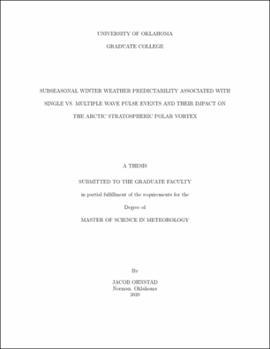| dc.contributor.advisor | Furtado, Jason | |
| dc.contributor.author | Ohnstad, Jacob | |
| dc.date.accessioned | 2020-07-27T18:34:50Z | |
| dc.date.available | 2020-07-27T18:34:50Z | |
| dc.date.issued | 2020-07-30 | |
| dc.identifier.uri | https://hdl.handle.net/11244/325304 | |
| dc.description.abstract | Variability in the Arctic stratospheric polar vortex can lead to extreme winter weather across the Northern Hemisphere, which can have large socioeconomic impacts. Dynamically, increased vertical wave activity from the troposphere into the polar stratosphere fluxes anomalous heat towards the pole, resulting in the warming and weakening of the stratospheric polar vortex. Characteristics of these vertical wave driving events are not well understood as they can vary in strength, duration, and location. This research addresses the knowledge gap associated with vertical wave driving characteristics and the impact they have on the stratospheric polar vortex. Here we compare the impacts of single versus multiple vertically propagating wave events entering the polar stratosphere in both ERA-Interim and hindcasts of operational subseasonal models in the Subseasonal-to-Seasonal (S2S) Prediction Project Database. Tropospheric height patterns that occur on the start day of single and multiple pulse events include anomalous ridging over Northern Eurasia and the North Atlantic as well as an anomalous trough or zonal trough-ridge pattern over the North Pacific. These anomalous patterns are co-located with large meridional heat flux anomalies during the events. Single pulse events have less persistent tropospheric features and are found to be relatively short-lived and weaker compared to multiple pulse events. As a result, the vortex is much weaker following multiple pulse events than single pulse events. The significant stratospheric anomalies that occur with these events more readily downward propagate into the troposphere following multiple pulse events versus single pulse events. S2S models capture well the spatial patterns of single and multiple pulse events on the start day of the event, but struggle to produce stationary features at later lags, such as blocking highs, which are important for producing multiple pulse events. In both reanalysis and S2S models, the North Pacific, Europe, and Siberia are the regions favored for the origin of the pulses. Analyzing these wave pulse events will shed light on the different characteristics which produce a wave pulse event and the impacts these events have on the stratospheric polar vortex which may subsequently improve subseasonal winter weather forecasts. | en_US |
| dc.language | en_US | en_US |
| dc.subject | Stratospheric Polar Vortex | en_US |
| dc.subject | Polar Vortex Disruptions | en_US |
| dc.subject | Wave interactions with the Polar Vortex | en_US |
| dc.title | Subseasonal Winter Weather Predictability Associated with Single vs. Multiple Wave Pulse Events and their Impact on the Arctic Stratospheric Polar Vortex | en_US |
| dc.contributor.committeeMember | Naoko, Sakaeda | |
| dc.contributor.committeeMember | Martin, Elinor | |
| dc.date.manuscript | 2020-07-24 | |
| dc.thesis.degree | Master of Science in Meteorology | en_US |
| ou.group | College of Atmospheric and Geographic Sciences::School of Meteorology | en_US |
